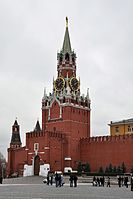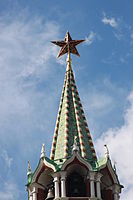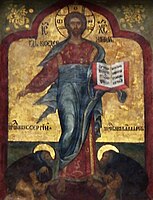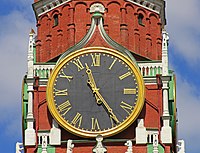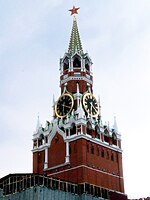Spasskaya Tower
| Spasskaya Tower | |
|---|---|
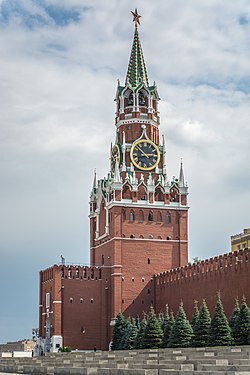 | |
 | |
| General information | |
| Location | Moscow, Russia |
| Opened | 1491 |
| Height | 71 metres (233 ft) |
| Design and construction | |
| Architect(s) | Pietro Antonio Solari |
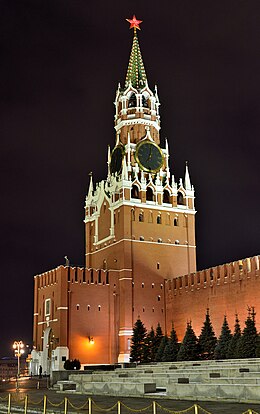
The Spasskaya Tower (Russian: Спасская башня, romanized: Spasskaya bashnya), also translated as the Saviour Tower, is the main tower on the eastern wall of the Moscow Kremlin which overlooks Red Square.
History
The Spasskaya Tower was built in 1491 by the
The Spasskaya Tower was the first tower of the many Moscow Kremlin Towers to be crowned with the hipped roof in 1624–1625 by architects Bazhen Ogurtsov and Christopher Galloway (a Scottish architect and clock maker).[2] According to a number of historical accounts, the clock on the Spasskaya Tower appeared between 1491 and 1585. It is usually referred to as the Kremlin chimes (Кремлёвские куранты) and designates official Moscow Time. The clock face has a diameter of 6 metres (20 ft).[3] The gate of Spasskaya Tower was used to greet foreign dignitaries, and was also used during formal ceremonies or processions held on Red Square.
Reverence and respect for the Tsar
The tower gate was once the main entrance into the Kremlin. In
"The Russians have always regarded the Spasskaya Tower with great reverence. According to old legends, the tower was possessed with miraculous powers and was reputed to protect the Kremlin from enemy invasion. People passing through the gates would always observe the custom of crossing themselves and doffing their hats to show their respect, and horses passing under the gates of the tower were said to shy. In fact, legend has it that Napoleon himself could not prevent his horse from taking fright as he rode through the gates, having failed to show his respect, and the French Emperor's hat was said to have fallen from his head."[4]
The Spasskaya Tower was commissioned to be built by Ivan III, or
Soviet Union and modern day uses
After the rise of the
The tradition of dismounting the horse and removing the cap ended during the Soviet era, when the Kremlin became the center of government and politics. Cars approached the gate head on from the Lobnoye Mesto and the road beside the GUM department store. All other traffic was routed through the Borovitsky gate.
Various cathedrals were demolished throughout the years to make room for other government buildings. It was not until 1955 during the rule of
The Spasskaya Gate posed an issue following in the 1990s, as the passage of vehicles disrupted the flow of pedestrians to GUM and other shopping centers. In 1999, the decision was made to finally close the gate to all traffic. The signal lights and guard platforms still remain. The gate is used occasionally when repairs must be made to the
In August 2014, Russian president Vladimir Putin suggested an idea for restoring Ascension Convent and Chudov Monastery, which were demolished by the Soviet regime in the 1930s. However, due to archaeological work which began in December 2015 and the lack of UNESCO's approval of the restoration, the restoration of Ascension Convent is currently unplanned. During archaeological work, experts have managed to find a foundation of the Chudov Monastery and Ascension Convent.[5]
Spasskaya Tower is also the honorific for the International Military Music Festival "Spasskaya Tower",[6] which is based within the grounds of Red Square.
In August 2010 the icon of Smolensk Saviour was uncovered and restored above the gate (see picture below). This begins the tradition of the parade inspector to remove his headgear and cross himself before the inspection of troops during all Moscow Victory Day Parades.
Beginning in 2016, there has been an hourly guard mounting ceremony by the Kremlin Regiment within the area of the gate.
Inscription on Spasskaya Gate
On top of the gates of Spasskaya Tower, there appears the following inscription (it is inscribed in Latin):
In Latin: IOANNES VASILII DEI GRATIA MAGNUS DUX VOLODIMERIÆ, MOSCOVIÆ, NOVOGARDIÆ, TFERIÆ, PLESCOVIÆ, VETICIÆ, ONGARIÆ, PERMIÆ, BUOLGARIÆ ET ALIAS TOTIUSQUE RAXIE DOMINUS, ANNO 30 IMPERII SUI HAS TURRES CONDERE FECIT ET STATUIT PETRUS ANTONIUS SOLARIUS MEDIOLANENSIS ANNO NATIVIT ATIS DOMINI 1491 KALENDIS MARTIIS IUSSIT PONERE.[7]
In English:
-
Spasskaya Tower in 1880
-
Spasskaya Tower
-
Spasskaya Tower at night
-
A Kremlin star (Spasskaya tower)
-
A Soviet stamp featuring the tower.
-
Spas Smolensky
-
Sanctification ceremony of the icon. August, 2010.
-
Location of the tower in the Kremlin marked with a circle.
-
Kremlin clock
-
Spasskya Tower after restoration (2015)
Notes
- ^ Zubacheva, K. (2019-12-30). "6 facts about Spasskaya - the Kremlin's main tower". Russia Beyond the Headlines. Retrieved 2020-01-29.
- ^ Shvidkovsky 2007, p. 151-156.
- ^ "Bigger Bens". go.galegroup.com.ezproxy1.lib.asu.edu. Spectator. Retrieved 7 November 2017.
- ^ "Saviour Tower in the Moscow Kremlin". www.moscow.info. Retrieved 27 November 2017.
- ^ "Московский Кремль: будут ли восстановлены Чудов и Вознесенский монастыри".
- ^ "History of the festival — [EN] Spasskaya bashnya". www.kremlin-military-tattoo.ru (in Russian). Retrieved 27 November 2017.
- ^ O.A. Belobrova. Latin inscription on the Frolov Spasskie gates of the Moscow Kremlin and its fate in the Old Russian literacy. GMMK. Materials and researches. New attributions. 1987, issue 5. p.51-57 Archived 2011-07-18 at the Wayback Machine
Sources
- Shvidkovsky, Dmitrii (2007). Russian Architecture and the West. London: Yale University Press. pp. 151–156. ISBN 978-0-300-10912-2.


